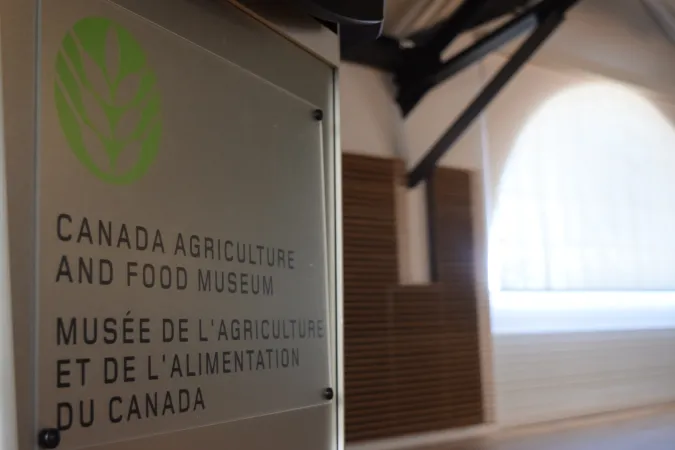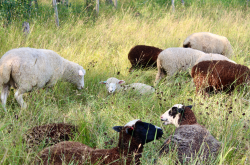Volunteer week: The Canada Agriculture and Food Museum offers an unusual museum experience
Here at Ingenium, National Volunteer Week (April 7-13) provides an opportunity to acknowledge and celebrate all of the volunteers who enhance the unique visitor experiences we provide across all three museums — the Canada Agriculture and Food Museum, the Canada Aviation and Space Museum, and the Canada Science and Technology Museum. Guest writer Connor Wilkie recently sat down with Ingenium staff members to talk about what makes the Canada Agriculture and Food Museum such a unique venue for volunteering.
The Canada Agriculture and Food Museum — a working farm in the heart of the Ottawa — is not your typical museum. So it’s fitting that volunteering at the museum isn't your typical experience either.
Cédric St-Amour, the volunteer coordinator for Ingenium, explains how the volunteer experience at this museum differs from others.
“The volunteers play a very important role in special events at the Canada Agriculture and Food Museum; every year we have major events that people are looking forward to,” says St-Amour.
Although the Canada Aviation and Space Museum and the Canada Science and Technology Museum do have some special volunteer projects, St-Amour emphasizes that the Canada Agriculture and Food Museum has a plethora of special events that draw large crowds. This means strong volunteer support is required to ensure that events go off without a hitch.
“The year’s events really start with Easter; at the farm Easter is huge. On average, we are looking at over 20,000 visitors over four days. So a large crowd in a very short time; volunteers definitely support the staff’s initiative,” says St-Amour.
Volunteers assisting with the Easter Festival are usually a dedicated bunch, with some working more than one shift throughout the four-day event.
“This year for Easter, we are expecting 12 to 16 volunteers per day over four days. In fact, many of the volunteers will do more than one shift. We have some volunteers who will actually be there two or three days over the weekend.”
St-Amour finds that one unique thing about the museum is the special connection that volunteers feel to it. He adds that some having maintained this connection throughout their youth.
“I find it interesting how people have a special bond and attachment to the Canada Agriculture and Food Museum, or as people affectionately call it, ‘the farm.’ For many people, they have been going there since they were a kid,” St-Amour explains. “Many of our high school volunteers are former campers there and they loved it so much as campers that they keep that connection by volunteering with us. And that’s a special bond.”
Volunteers have many opportunities throughout the year to help out at the museum. They can participate in the many festivals — like Easter and the Ice Cream Festival — as well as special events like Baconpalooza.
“We start the year with Easter and kind of wrap it up with Halloween. This is another major activity at the farm, volunteers and visitors get to dress up for it,” says St-Amour.
Volunteers at the museum can expect a hands-on experience. According to St-Amour, the museum offers jobs and activities that keep volunteers active and on their feet.
“For Easter, volunteers can be expected to greet visitors and show them where to go. So doing a bit of wayfinding,” says St-Amour. “They will support crafts and games; we also bring out a few animals for people to take photos with. So, we have volunteers to make sure that the animals are safe and people have a safe experience taking their photos as well. That is the most popular station for volunteer requests.”

Menal Zeghal, a volunteer at the museum, wrote about her own experiences volunteering last year for National Volunteer Week.
Arianne Richeson, an education officer for the museum, feels that people are sometimes drawn to volunteer with the museum because of their passion for animals and the unorthodox museum atmosphere.
“I have a sense that many people are drawn to our museum because they have a passion for animals and enjoy a slightly less formal environment,” Richeson explains. “Most of our work involves working with kids, so our volunteers are sometimes drawn to our site because it is popular with families.”
Being located in the heart of Ottawa, the museum offers volunteers a chance to experience rural life in the city.
“Volunteering at the museum is a great way for urban residents to get a taste of rural life at a farm in the heart of the city.” says Richeson.
At the museum, you can expect the unexpected. Richeson says the unpredictability of the day-to-day farm life provides an unusual feature to the volunteer experience.
“You also never know what will happen from one day to the next! Since we have live animals on site, a volunteer might have a shift on a day that new lamb or calf is born. That’s a pretty special aspect of the volunteer experience.”





















